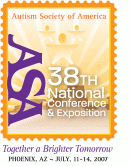 |
The ASA's 38th National Conference on Autism Spectrum Disorders (July 11-14, 2007) of ASAThe Westin Kierland Resort & Spa, Scottsdale, AZ |
| For a complete author index with session numbers, please click here | |
| Friday, July 13, 2007: 10:30 AM-11:45 AM | |||
| Rainmakers Ballroom C | |||
| #2551- Autism Tissue Program Brain Research- ASHA CEU Session* | |||
| For over a decade, researchers have made enormous advances in studying brain structure and function in individuals with autism. While many of these breakthroughs have been the result of research using indirect methods such as neuroimaging techniques, other scientific advances which study autism on a cellular and molecular level have required the use of brain tissue for study. The Autism Tissue Program was established over 8 years ago and as a result, over 56 research projects have been made possible using brain tissue. A summary of the most recent findings using brain tissue will be discussed, including how these studies fill in major gaps in what scientists know about the nature of autism, what causes it and potentials for new targeted interventions. Families and those not directly affected by autism are encouraged to attend to learn more about the research and how anyone can play a part in educating others.
| |||
| Presenter: | - Jane Pickett PhD, Autism Tissue Program Director, combines a background of basic molecular biology/neuroscience research and clinical experience. She coordinated the development of the program in 1988 following a research appointment at Princeton University/NASA. Clinical experience includes supervision of a college department of Counseling and Testing and providing case management to the developmentally disabled. Hospice volunteer work has been helpful in supporting families of brain tissue donors. She has authored numerous articles in both parent and professional journals, most recently JNEN in 2005. She has presented internationally to both parent and professional autism organizations on the neuropathology of autism | ||
|
| |||
|
The Autism Tissue Program has a singular goal – to acquire brain tissue to speed up autism research. Brain research must be relevant to everyday life for anyone to want to support this program. The purpose of this presentation is to relay the latest information about brain research and associated genetic, environmental and neurodevelopmental progress – and to better understand the parent's or adult's perspective of brain donation. Topics: Brain and Behavior The core language, social, repetitious autistic behaviors are produced in the brain. Other behaviors such as seizures, mental retardation, and unique or exceptional behaviors also are caused by changes in brain development and/or maturation. The relationship between major brain structures and behaviors will be presented. Neurodevelopment - genes and environment Pre- and post-natal risk factors and how they affect brain development and can contribute to autism. Multidisciplinary Research The post-mortem brain allows investigators to compare brains of those with and without spectrum disorders. Ground-breaking research (cortical changes, mirror neurons, amygdala) in the past two years will be covered using illustrations and easy to understand explanations of this complex subject. An update on mortality studies will be provided. The future - brain cells live on. Living neuronal stem cell cultures from post-mortem brains - the new Autism Tissue Program initiative and future of research. |
|||
See more of General Submissions
See more of The ASA's 38th National Conference on Autism Spectrum Disorders (July 11-14, 2007)